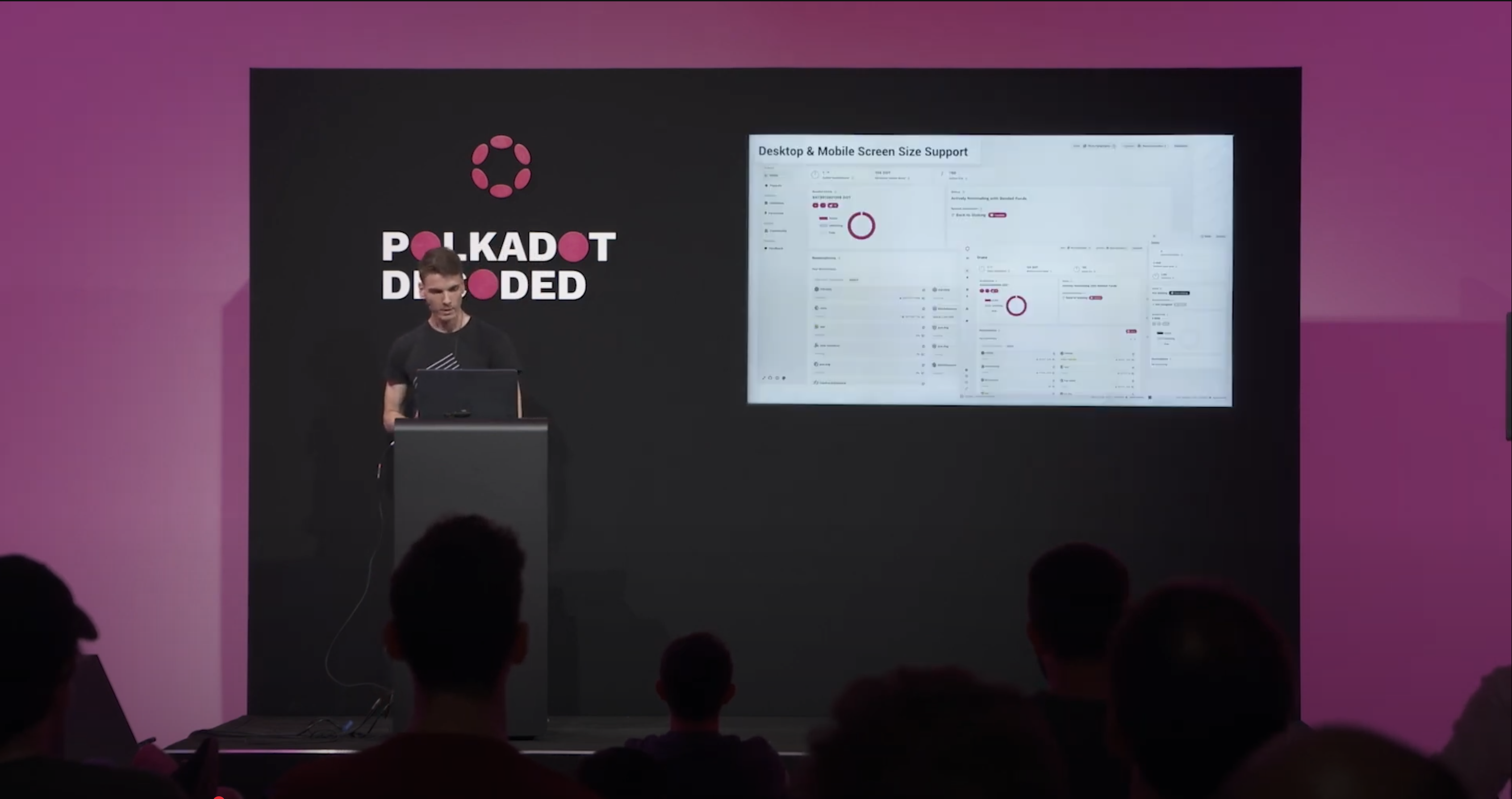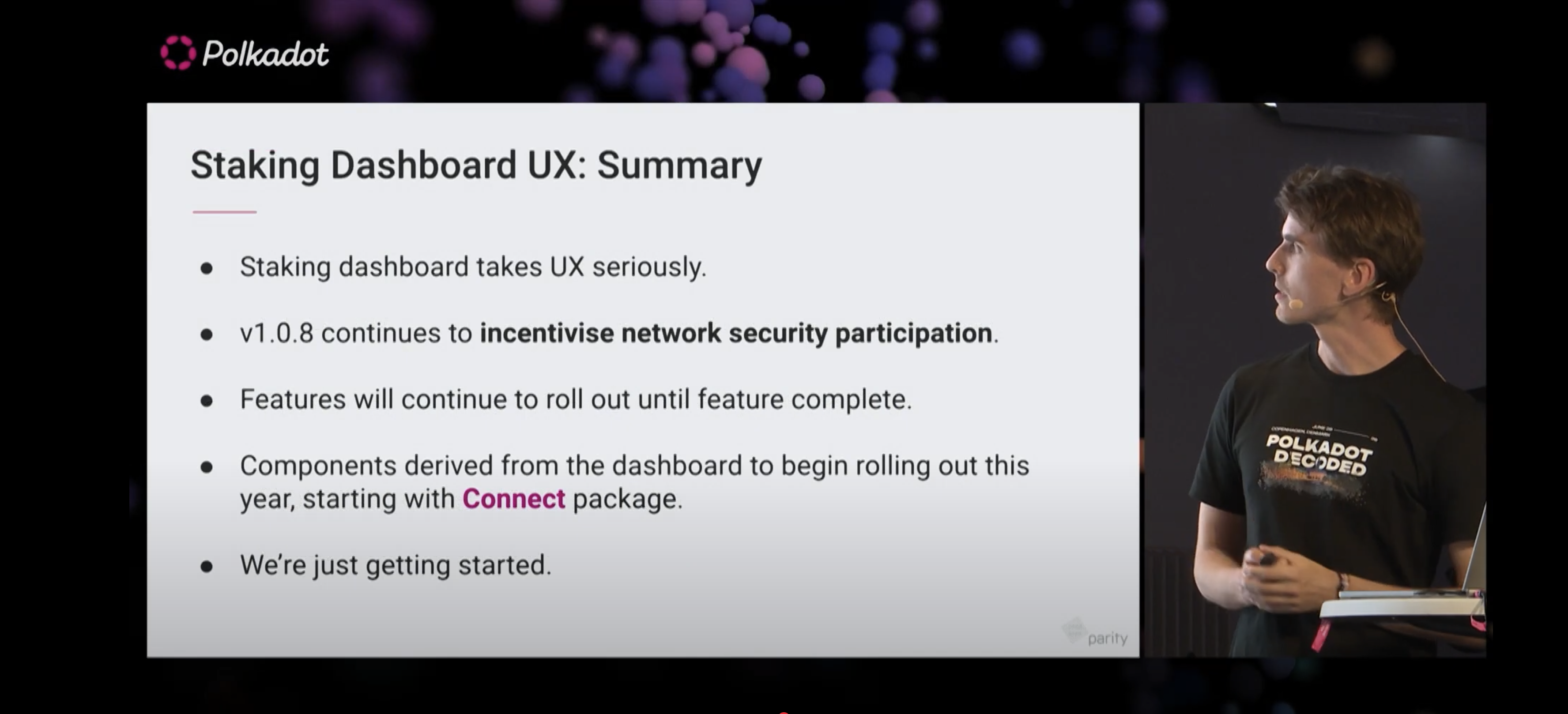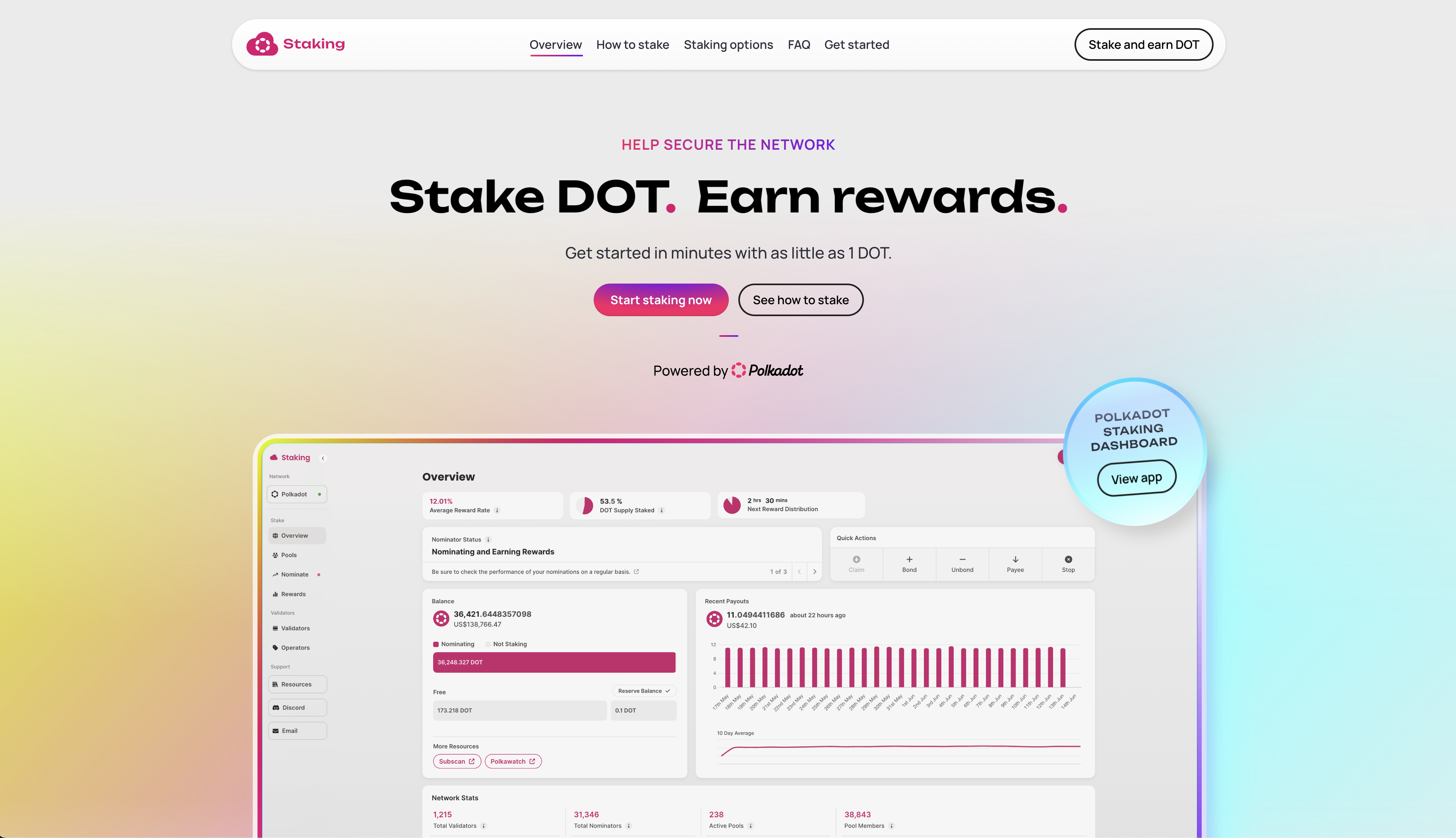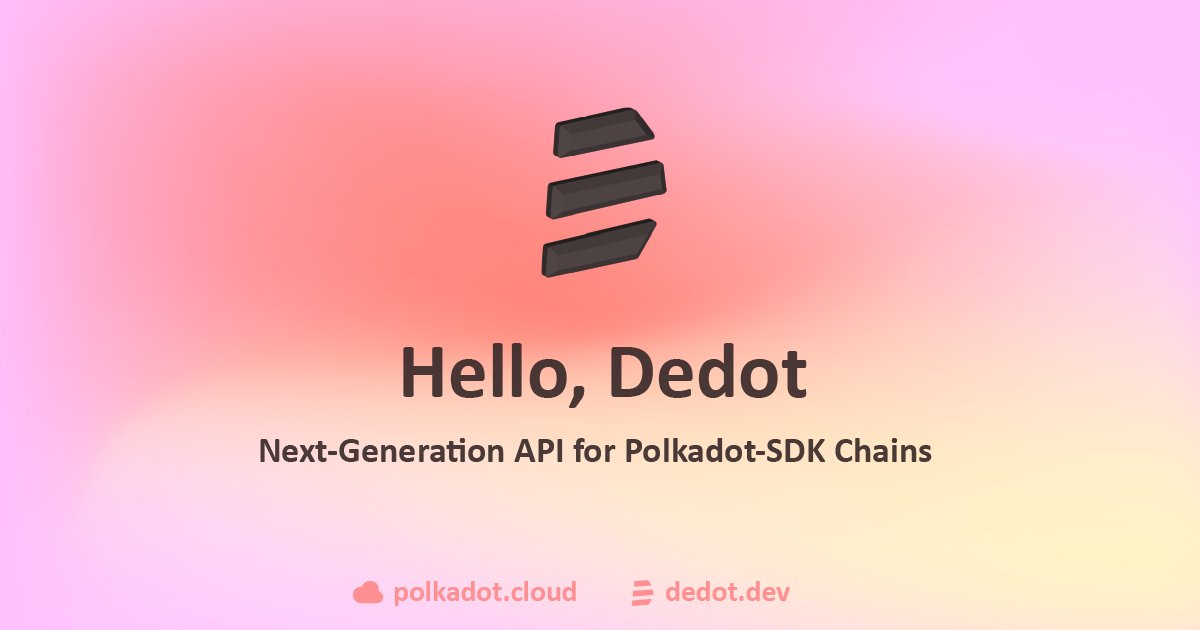Polkadot Cloud Staking Journey and JS Apps Staking Sunset Steps
Since launching in 2023, the Polkadot Staking Dashboard has grown from a user-friendly alternative to Polkadot JS Apps into the flagship staking interface for the ecosystem. This article reflects on that journey, the architectural breakthroughs, and the path toward sunsetting JS Apps Staking entirely.
In 2025, we undertook a major architectural evolution of the dashboard, abstracting its codebase to be fully network-agnostic while integrating cutting-edge APIs for seamless multi-chain support. This strategic shift enabled us to achieve:
-
Scalable, lightweight Staking API: Designed to handle complex queries beyond the capabilities of the node itself—such as historical reward data, era exposure checks for fast unstaking status, and other intensive operations.
-
Dedot API integration: Integrated the Dedot API—the next-generation JavaScript client for Substrate-based chains—positioned as the modern successor to the Polkadot JS API for improved performance, maintainability, and developer experience.
-
Multi-network NPoS support: Enabled both the Staking Dashboard and Staking API to seamlessly support any network implementing Nominated Proof of Stake (NPoS), ensuring broad compatibility across the Polkadot ecosystem and beyond.
The Staking Dashboard has also maintained its pro-collaboration stance in a number of ways, including the ability to be fully functional even when the Staking API is disabled, allowing networks to onboard themselves to the staking dashboard before support rolls out on the Staking API side.
Journey of the Staking Dashboard
For the Staking Dashboard to replace the staking functionality in JS Apps, it must not only match JS Apps feature-for-feature but also surpass them in key areas so users feel compelled to switch.
Since its inception, the dashboard has aimed to deliver a cleaner, more user-friendly experience than JS Apps while maintaining the same commitment to unbiased design.
Problems Solved on Initial Release

When the Staking Dashboard first launched, it set out to resolve key usability and accessibility issues that had long affected the experience on Polkadot JS Apps. Notable improvements included:
-
Guided staking setup: A step-by-step onboarding flow for nominators, featuring one-click optimal validator selection based on current network metrics—eliminating the guesswork and manual validator research required by JS Apps.
-
Advanced validator discovery: A fast, paginated validator browser with powerful filters (e.g., commission, identity, active/inactive status), replacing the monolithic, slow-to-load validator list used in JS Apps that hindered discovery and comparison.
-
First-class hardware wallet support: Direct integration and open-sourcing of support for Ledger devices and Polkadot Vault—pioneering secure offline staking. This foundation later expanded to include support for WalletConnect, making secure access more flexible across devices.
-
Consistent and predictable UI: A refined, state-aware interface designed to keep the dashboard visually consistent across all usage scenarios, minimizing user confusion and interface surprises—especially when transitioning between states like bonding, nominating, and unbonding.
These were fundamental improvements that the initial dashboard components were built around. The engineering model adopted was very much agile, with rapid iteration on ideas and receiving user feedback.
Problems Solved Mid-1.x Cycle

As the codebase of the dashboard started to formalise, more enhancements were added to the UI that further improved the usability of the NPoS system, such as validator performance graphs that sit alongside each user’s nominations for users to see performances at a glance, and the deprecation of controller accounts.
This era involved continuous upgrades to the dashboard. I shared a number of updates to the community as dashboard updates were rolling out.
-
1.3 (8 Apr 2024): Introduced the first dedicated Nomination Pool workflow: a new “Join Pool” canvas with batched pool-performance fetching, progress bars, and low-member-pool prioritisation. Added a “Start Nominating” wizard, extension disconnect flow, colour-polish, and multiple UX bug-fixes (e.g., search-bar and Polkagate-Snap issues).
-
1.4: (18 Apr 2024): A mainly refactor & hardening release: moved Ledger/Vault account handling to a network-parameterised API and replaced many low-level helpers with the shared @w3ux/utils library. It also patched free-balance display, search filters and pools unsubscription logic.
-
1.6 (1 Aug 2024): Rolled out People Chain identity support, generic Ledger-app signing, and a “Nominee Decentralisation” insight showing how distributed a user’s nominations are. Under the hood it abstracted state bootstrapping, refreshed logos, and removed obsolete reward code, plus several Ledger and Vault fixes.
-
1.7 (8 Nov 2024): Focused on UX polish and connectivity: brand refresh (new logo & fonts), WalletConnect integration, lighter pool-item UI, and hook refactors (useSize, useTimeLeft, resize listener throttling removed). Also upgraded to the latest @w3ux utilities and fixed era-subscription and account bugs.
-
1.8 (16 Jan 2025): Began the monorepo split (app, ui-core, ui-overlay, etc.) and shipped deep Staking API GraphQL integration: historical pool-rewards and nominator-rewards moved off Subscan, light-client now boots from WSS nodes only. Added a 100% commission warning, disabled dual-staking, and normalised titles/assets across packages.
-
1.9 (27 Feb 2025): Announced as “faster, smarter, more rewarding” — this release deepened Staking API hooks, unveiled an overhauled Rewards page with earnings projections, improved Ledger support, delivered initial WalletConnect v2 tweaks, and re-branded the project to Polkadot Cloud Staking.
-
2.0 (18 June 2025): Marketed as the biggest update to date, v2.0 pairs a re-engineered API layer with a fully-refined UX, resulting in lightning-fast data loading and smarter staking flows. It lays the groundwork for seamless multi-chain support and positions the dashboard as the reference staking front-end for the Polkadot ecosystem.
A Rocky Transition to Polkadot Cloud
In mid-2024 the Polkadot Staking Dashboard project faced some strong headwinds amid major structural changes within the Polkadot ecosystem:
-
Project migration: The Staking Dashboard transitioned from an internal Parity project to an independent one, moving from
paritytech/polkadot-staking-dashboardtopolkadot-cloud/polkadot-staking-dashboard. -
Funding shift: Ongoing funding for the project transitioned to OpenGov.
-
Hosting migration: The application was moved from the official
polkadot.networkdomain to its new home at polkadot.cloud. -
Landing page decommissioned: The former staking landing page on
polkadot.networkwas taken offline, removing the primary entry point for new stakers on Polkadot. -
Team & partnerships rebuilt: The original team structure and partnerships were reset, requiring a complete rebuild of the core team and collaborative relationships.
While this period posed an existential threat to the Staking Dashboard, it also served as a catalyst for deep strategic reflection. It forced us to re-evaluate the dashboard’s long-term value within the ecosystem, ultimately paving the way for pivotal architectural and product decisions in the months that followed:
-
Reintegration of the dashboard into the Polkadot Cloud platform, strengthening its alignment with broader ecosystem goals.
-
Exclusive reliance on the Dedot API for all node interactions, backed by a strong collaborative relationship with its core developers. We view Dedot as the future of JavaScript-based chain interactions—and it has proven flawless in execution thus far.
-
Scalability through the Staking API, purpose-built to handle large-scale data requests via a high-performance GraphQL backend.
-
Restructuring of the codebase into a monorepo workspace, improving modularity, separation of concerns, and enabling more robust testing practices.
-
Complete re-architecture of the state and API layers, laying the foundation for seamless multi-network support beyond Polkadot, Kusama, and Westend.
-
Expanded user support, with the introduction of Discord and email channels offering same-day responses to support inquiries.
-
Agile to CI/CD development model, enabling rapid iteration and deployment of new features, bug fixes, and performance improvements, with additional inclusion of AI tools to assist with development and testing.
Many of these ideas were integrated into the Mid 2024 Staking Dashboard OpenGov proposal, which have now all been implemented.
Despite the turbulence, the Staking Dashboard emerged stronger than ever and is now firmly positioned for long-term success. The launch of the new Polkadot Cloud Staking landing page marks a symbolic milestone—proof that we have overcome our challenges.

Staking API: Problems Solved
The Staking API has become a core component of the Polkadot Staking Dashboard experience. Since the dashboard’s initial release, the Nominated Proof of Stake (NPoS) system has scaled significantly—introducing data volumes that make certain operations infeasible to handle through node interactions alone. Consider the following metrics:
- At launch, there were 297 active validators per era. Today, that number has grown to 600, with plans to expand further.
- Previously, only a limited number of nominators per validator received rewards—totaling around 21,500 rewarded nominators per era. Now, all nominators backing active validators are rewarded.
- Era exposure chain state is now paginated, supporting a much larger number of exposures than before.
- As of writing, there are over 38,000 nomination pool members participating across 239 active pools on Polkadot. Handling such high-volume data is no longer practical within a front-end application alone.
As NPoS continues to scale, some chain state now require indexing in optimised databases for fast querying - that is the role of the Staking API.
Staking Dashboard 2.0 and Beyond
Each Staking Dashboard release raises the stakes for the Polkadot Cloud platform, and our 2.0 release was no different. Our biggest update yet achieved the following:
-
Dedot-first architecture – Polkadot JS API was removed entirely and replaced by a Dedot-powered “global-bus” layer, unifying all chain calls and dramatically reducing load times.
-
True multi-currency display – balances, rewards and payouts can now be displayed in 27 fiat currencies.
-
One-click pool & nominator setup – revised onboarding flows let users bond, join a pool, or nominate a curated set of validators with a single action, replacing several manual steps.
-
New “Quick Actions” & expanded Overview – a context-aware action bar plus richer balance widgets put the most common tasks (bond, rebond, withdraw, etc.) one tap away.
-
Nomination-pool invites & smarter management UI – invite links, full-screen management, and simplified confirmation dialogs make pool coordination far easier.
-
React 19 + UI overhaul – upgraded to React 19, introduced SimpleBar-based scrolling, canvas max-width controls, and a cleaner header with new Account/Settings pop-overs for a sleeker feel.
-
Unified wallet & hardware flows – Ledger, Polkadot Vault and WalletConnect are now handled by a single provider layer, streamlining account selection and signing.
-
Light-client improvements – chain specs now come from
@substrate/connect-known-chains, giving the embedded Smoldot client faster boot-strapping and broader chain coverage. -
Developer-experience boosts – the monorepo migrated from Yarn to PNPM and had its TS configs slimmed down, cutting build times and CI latency.
With its latest additions, Polkadot Staking Dashboard is now in a position where we can entertain a complete sunset of JS Apps Staking.

Add Your Network to Staking Dashboard
We actively encourage ecosystem teams to collaborate with us and integrate their networks into the Polkadot Cloud platform. Multi-network support is a key part of the dashboard’s future direction, and expanding coverage beyond Polkadot, Kusama, and Westend unlocks powerful new capabilities for users and developers alike.
As more networks are added, the dashboard will evolve into a unified interface for staking across the entire ecosystem—enabling features like cross-network statistics, aggregated staking rewards across multiple tokens, and a broader analytics layer that reflects the diversity of Substrate-based networks.
Integrating your network is a straightforward process, and we’re here to support each step:
- Add your network metadata to the supported networks list.
- Include your chain icons in the dashboard’s static assets.
- Provide a light client chain spec for Smoldot compatibility.
- Configure CSS variables to enable a custom dashboard theme for your network.
- Supply your Dedot API service, which defines all supported chain interactions and the required API instances.
Once integrated, we can work closely with your team to extend support to the Staking API—unlocking full data scalability and enabling advanced features like historical reward tracking, high-volume querying, and performance insights tailored to your chain.
